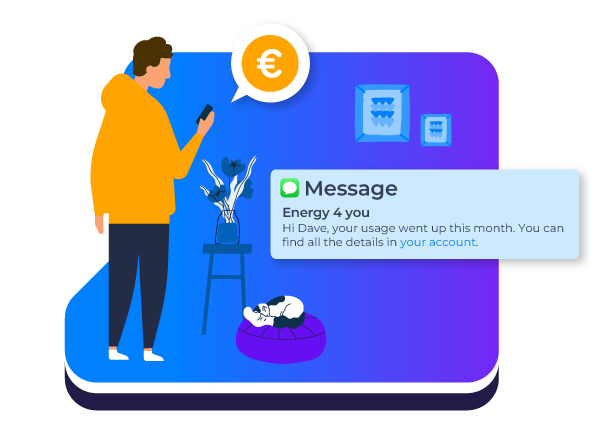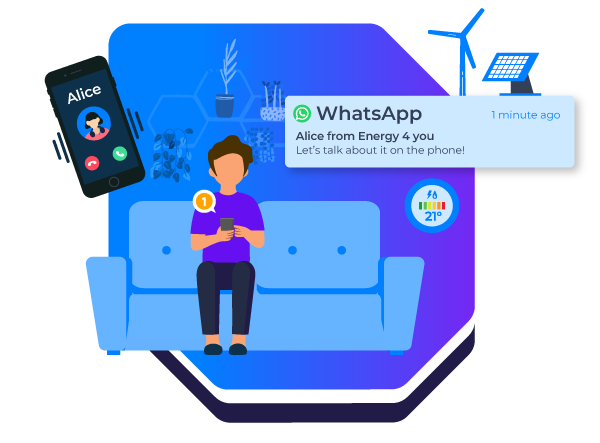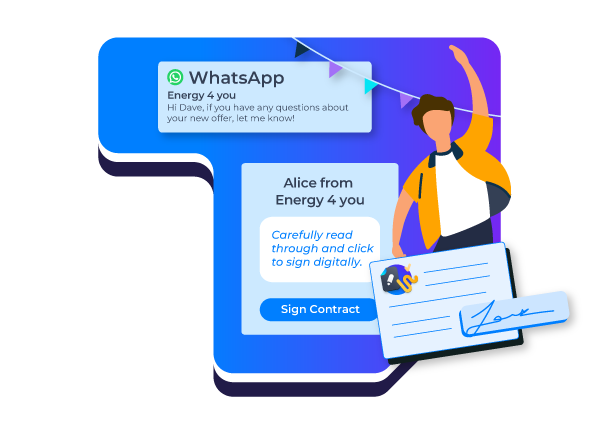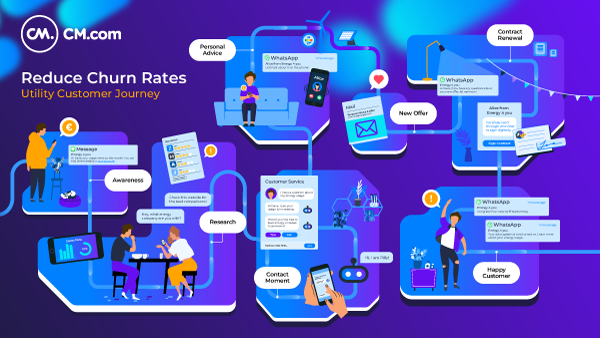- 1. Awareness: Unpleasant Surprise or Proactive Service?
- 2. Research: I Want to Know More
- 3. Contact Moment: I Have a Question and Need Advice
- 4. Personal Advice: Continuing the Conversation
- 5. New Offer: Delighting Dave
- 6. Contract Renewal
- 7. Happy Customer and Retention
A lot of utilities customers are seeing price rises for life’s essentials: electricity, gas, and broadband. For many customers, an unexpectedly high invoice is a critical touchpoint — it’s where they feel annoyed, survey competitor offers, and look to switch. Many will do so without even contacting you … despite having a choice of phoning, emailing, texting and more.
That’s a shame because if they do reach out, you have some options. Maybe there’s an offer they qualify for, a discount you can apply that’ll retain their goodwill. But when you’re rolling out price rises to hundreds of thousands of customers, how can you soften the blow? Your Customer Service team is good—but not 100,000 outbound calls a day good.
As you understand by now, the customer journey of utilities exists of different touchpoints and interactions where you can engage with customers. Read on and learn more about these phases and how to add value to customer interactions.
1. Awareness: Unpleasant Surprise or Proactive Service?
The best time to engage with a customer is before you need to. For example, informing them of a rate rise in advance and offering help. If you’ve got the data, why not personalise that contact — empathising with the customer’s problem by making them feel you’re taking a genuine interest?
Phase 1, awareness, can be that simple: perhaps a single SMS message informing the customer (let's call him Dave) that his energy usage has risen, with a link to his account so he can check. Make sure that important information is transparent for Dave and start the conversation, proactively.

2. Research: I Want to Know More
So they check their account — wondering whether there’s a better deal you can offer them. But being human, they check the market and talk to their friends too. Of course, you’re part of that research and discussion phase.
So the customer’s in research mode. What matters here is to be ready when they have a question, and be aware that customers gather information via different sources.
3. Contact Moment: I Have a Question and Need Advice
Many customers won’t hit the phone yet — they’ll head back to your site or app and look for a way to contact you. It’s time to start talking. For example via a chatbot. A well-built chatbot doesn’t just respond to recognisable questions, important as that is. It uses what it knows about the customer as an individual.
Imagine your chatbot recognises Dave — remember, he’s logged in — and uses data (SMS sent, site visit made) to instantly empathise? Not “Hello, how can I help?” but “Hello Dave, I see your usage is increasing” What a win! It’s instant, it’s personable, and it anticipates his problem. You’re on the right track.
4. Personal Advice: Continuing the Conversation
You’ve added value to another touchpoint and now the customer’s talking to you about solutions. The chatbot understands Dave’s concerns and can trigger another customer interaction: perhaps an SMS, perhaps a reach-out on WhatsApp by a human agent, perhaps an outbound call.
Key here: the course of action is prompted by the customer’s deeds. Different events require different levels of service. Whatever matters to Dave is what gets done.

5. New Offer: Delighting Dave
Perhaps the response is a call to Dave, after another message telling him to expect an offer by mail. When that call arrives, Dave’s already impressed —which makes him even more receptive to the offer.
Churn risk has been neutralised. A human agent makes him a fresh offer and updates his contract there and then.
6. Contract Renewal
Contract renewal is another critical touchpoint: it’s all about making things as easy as possible for the customer — because that means efficient and cost-effective for the utility provider. So signing that contract happens with a single click and he’s done. No packs of paperwork to deal with — another cost centre saved.

7. Happy Customer and Retention
Enter delighted Dave. He’s not just happy about his lower prices — he’s happy that you did the work for him, reaching out and understanding his concerns. And you did it on the channels he prefers, too! It all came together and you proactively engaged with Dave at the right moment and time. That’s how you add value to the customer experience.
Thanks to understanding Dave's issues and using his data effectively, it took minimal effort; more smart thinking than hard working. All because you were watching and listening for signs a customer was in distress… and when it happened, you took action. Much of it is automatic. It doesn’t get any better than that.
Download the Utility Customer Journey infographic here

So there you have it: the different phases and touchpoints on the utility customer journey. Intrigued by how all these channels, touchpoints, and moments come together? Contact us to learn about adding value to your customer experience and start engaging with your customers today!
